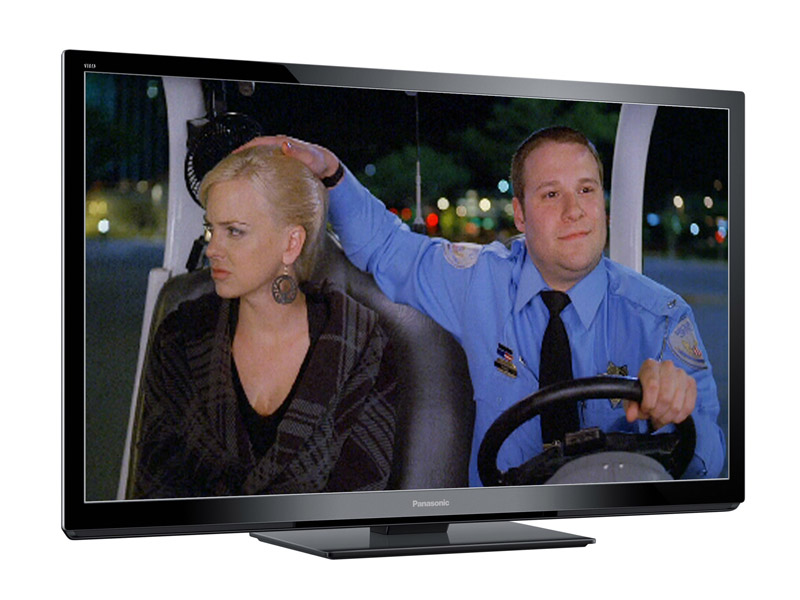Why you can trust TechRadar

Given how good last year's GT20 models were, the extent of the improvement delivered by the TX-P50GT30B is startling.
Starting with 2D playback, it's instantly obvious that the picture is much richer, punchier and more dynamic than that of its predecessors, with greater brightness, an enhanced contrast impression and, perhaps most striking of all, more vibrant colours.
The exceptional brightness of the TX-P50GT30B's pictures is not at the expense of black level response. On the contrary: the fact that the TX-P50GT30B's self-emissive (as opposed to backlit) plasma nature enables it to show bright and dark footage onscreen simultaneously without compromising either means the enhanced brightness of the light parts of the picture makes dark picture elements deeper than on previous screens.
While the panel improvements deliver levels of vibrancy much closer to the sort of eye-catching levels associated with LCD/LED technology, the richer saturations are delivered without spoiling Panasonic's long-celebrated ability to deliver natural, cinematic colours. Even mid-tone greens and reds – a regular problem for plasma TVs – are both totally believable and in harmony with the rest of the palette.
There also seems to be slightly less banding in colour blends than there was with the GT20 models and the extra saturation richness helps pictures look more solid and layered.
The TX-P50GT30B also improves on the black level response of its predecessors. There's greater depth, a more neutral tone to the black colour and a slight increase in shadow detail.
These qualities are complemented by near-eradication of the low-level green/grey dot noise that can plague plasma scenes and the way the panel's redesigned filter seems to gobble up ambient light. As ever, though, running the set in as dark an environment as possible will yield the best results.
It's also worth remembering that plasma screens don't suffer from either the horizontal viewing angle limitations or potential backlight inconsistencies that routinely plague LCD/LED TVs. The TX-P50GT30B also seems able to suppress the dotting noise over skin tones that was quite common on plasma TVs until very recently and its motion is slightly cleaner and more fluid than on previous models.
This, together with an input lag that measures only around 18ms, makes the TX-P50GT30B a very nice gaming monitor, so long as you're careful about the image retention issue.
There's still a touch of colour trailing around bright objects when watching PAL/50Hz sources, but it is seldom noticeable except, perhaps, during sports broadcasts, over the white lines on a pitch.
The last thing to report about the TX-P50GT30B's 2D images is that they are superbly sharp and detailed with HD material. This is hardly uncommon with Panasonic's mid to high-spec plasmas, but the crispness of the TX-P50GT30B's HD pictures seems even greater than usual, perhaps because of the image's increased dynamism and a reduction in accompanying noise.
There's not quite as much sharpness with standard-definition sources as you get from one or two rival brands, but upscaled pictures are reasonably free of noise and impressively natural, at least with its resolution boosting tool set to 'Medium'.
The panel improvements introduced under the NeoPlasma banner have an even more profound effect on 3D playback than on 2D. Panasonic's active shutter glasses still knock out more brightness from plasma 3D images than you'll see with any active 3D LCD screen, but three-dimensional pictures still look more vivid and punchy, thanks to the screen's ability to generate more brightness and richer colours.
This helps 3D pictures look more eye-catching and engrossing, as well as delivering a greater sense of the full HD detailing made possible by active shutter technology. Even more importantly, the brighter look of the TX-P50GT30B's 3D images means that dark parts in 3D footage avoid the hollow, crushed look that was evident on the GT20 series.
Shadow detailing in dark areas remains an area where good LCD TVs hold an advantage over plasma, but the gap between the technologies is rapidly decreasing.
The TX-P50GT30B's 3D images can cause a flickering effect due to the shuttering effect of Panasonic's glasses if you're watching the TV in a bright room, though. Also, the rather clumsy design of Panasonic's current glasses means you might well have to perch them on the end of your nose to line up them up properly with the screen, which means that light can get in behind them to distracting effect.
Of course, the main reason plasma has proven such a success with 3D is that it seems much less prone to crosstalk noise. The TX-P50GT30B continues this theme, suffering scarcely at all from the dreaded double ghosting. If you look really hard you can still see occasional traces, but the issue is so small as to be negligible.
The TX-P50GT30B's 2D-3D processing is solid enough, but it only works really effectively when set to a depth of field so shallow it's arguably not worth bothering with. And anyway, 2D to 3D conversion is never going to be as satisfying as a true 3D source.
The only really serious issues you might have with the TX-P50GT30B's pictures are the aforementioned colour bleed sometimes evident with PAL sources, and image retention. The former is pretty easily minimised by calling in the set's Intelligent Frame Creation system on its Medium setting, which improves motion fluidity and reduces colour seeping without creating many unwanted side effects.
The image retention issue, meanwhile, is avoided simply by being careful not to leave a static image or image element on screen for too long and by using the provided pixel orbiter and screen 'wash' features, but it's still a little troubling that (seemingly only temporary) image retention seems more easy to cause on the TX-P50GT30B than it has been on the past couple of Panasonic plasma generations.
Panasonic has slightly stolen its own plasma 3D thunder by all but obliterating crosstalk on the TX-L32DT30B, but the innovations introduced to 2011's Panasonic's plasma technology ensure that it still sets the 3D and 2D bar high enough to give most rivals sleepless nights.
Current page: Panasonic TX-P50GT30B: Picture quality
Prev Page Panasonic TX-P50GT30B: Features Next Page Panasonic P50GT30B: Sound, value, ease of useJohn has been writing about home entertainment technology for more than two decades - an especially impressive feat considering he still claims to only be 35 years old (yeah, right). In that time he’s reviewed hundreds if not thousands of TVs, projectors and speakers, and spent frankly far too long sitting by himself in a dark room.

